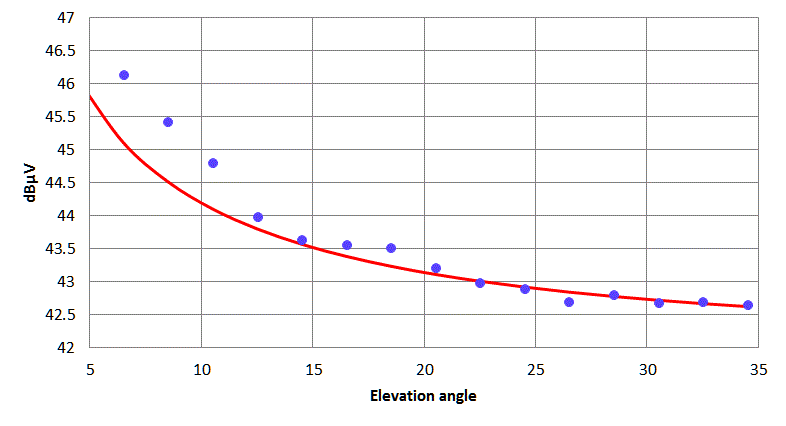
Separation of the Noise Background from Sky and Receiver
Joachim Köppen Strasbourg 2007, 2013

Above is the background level from the empty sky measured at various elevation angles, in 2007 during the Valentine Sky Survey by Marc Cornwall. We note that the background increases towards the horizon.
These data can be interpreted in this way: The measured noise comes partly from the receiver (essentially from the first transistor in the LNB) and partly from the sky. At low elevation angles, the telescope looks through a longer column of the Earth atmosphere, and since the air is at a certain temperature, it also emits thermal radiation; the longer the column of air is, the greater is the intensity. In the simple model of a planar and uniform atmosphere, the air column increases like
The receiver noise will be independent of the elevation, and hence we get a simple formula for the power received by the telescope:
Since we measure all powers in logarithmic dB values, we have to convert them into linear power values (P = 10**(dB/10)). Then a linear fit gives the two constants P_RX = 14617 and P_sky = 2137:
To avoid any contribution from the ground, it is better to use only data from elevations higher than 10°. This is merely a precaution, as the plot shows that those data points (down to about 5°) would also be in agreement with the linear relation ...
We could also have expressed the formula with dB values:
A simpler and quicker approach is a linear fit to the dB values, as shown here:
As every position requires several minutes to accumulate a number of measurements sufficient to get a reliable average value, it is better to take measurements only at elevations that render useful information, i.e. that are equally spaced in 1/sin(el). It turns out that a sequence of 10°, 20°, 30°, and 60° gives good results.
From observations done in this manner under various weather conditions permit to compile this table below which shows that the slope is clearly related to the water content in the atmosphere. This is because at 10 GHz absorption by water molecules becomes important. Thus, clear blue skies give a flat slope, rain and thick clouds make the relation steeper. However, grey skies may only mean a thin layer of high fog, but humid polluted air shows up in the slope value:
| date | RX noise [dBµV] | slope | weather |
| 19 jun 2011 | +38.62 | 0.127 | blue sky |
| 15 nov 2011 | +39.08 | 0.166 | fair |
| 7 dec 2011 | +38.34 | 0.455 | overcast, rainy |
| 7 dec 2011 | +38.71 | 0.367 | overcast, rainy |
| 7 dec 2011 | +38.64 | 0.346 | overcast, rainy |
| 4 jan 2012 | +38.39 | 0.151 | slightly overcast |
| 4 jan 2012 | +38.72 | 0.132 | slightly overcast |
| 25 jan 2012 | +38.52 | 0.128 | fair, some clouds |
| 3 feb 2012 | +39.28 | 0.103 | clear sky |
| 13 mar 2012 | +38.47 | 0.105 | sunny |
| 13 mar 2012 | +38.48 | 0.120 | sunny |
| 13 mar 2012 | +38.68 | 0.106 | sunny |
| 16 mar 2012 | +39.13 | 0.087 | sunny |
| 16 mar 2012 | +38.96 | 0.120 | sunny |
| 18 mar 2012 | +40.06 | 0.330 | overcast, rain |
| 18 mar 2012 | +40.05 | 0.380 | overcast, rain |
| 21 mar 2012 | +39.61 | 0.140 | sunny |
| 21 mar 2012 | +39.68 | 0.110 | sunny |
| 21 mar 2012 | +39.76 | 0.130 | sunny |
| 29 mar 2012 | +39.62 | 0.109 | sunny |
| 29 mar 2012 | +40.04 | 0.113 | light overcast |
| 27 jul 2012 | +39.40 | 0.373 | sun, clouds, humid: peak of pollution |
| 20 oct 2012 | +38.12 | 0.104 | clear sky |
| 18 nov 2012 | +38.41 | 0.132 | high fog |
| 11 dec 2012 | +38.77 | 0.117 | cloudy, snow |
| 24 jan 2013 | +38.73 | 0.140 | overcast |
| 24 jan 2013 | +38.80 | 0.170 | overcast |
| 24 jan 2013 | +38.70 | 0.213 | overcast |
| 7 feb 2013 | +38.58 | 0.160 | light overcast |
| 7 feb 2013 | +38.95 | 0.170 | light overcast |
| 7 feb 2013 | +38.92 | 0.162 | light overcast |
| 7 feb 2013 | +38.89 | 0.150 | light overcast |
| Top of the Page | Back to the MainPage | to my HomePage |
last update: oct 2020 J.Köppen